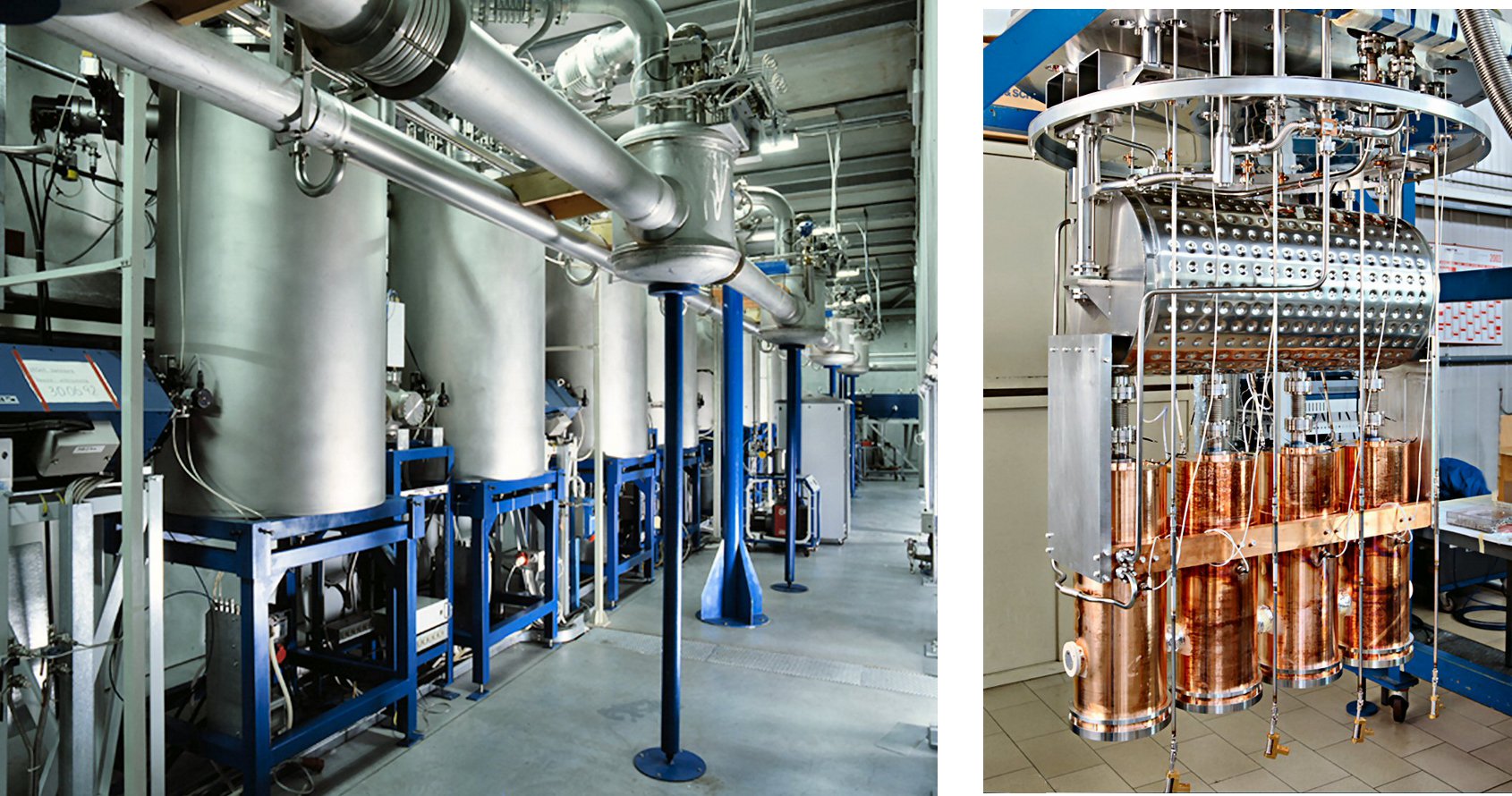At LNL, the ALPI (which stands for “Acceleratore Lineare Per Ioni” in Italian) linear accelerator is placed next to the Tandem XTU accelerator vault and receives the pre-accelerated beam via a transmission line, equipped with magnetic dipoles and magnetic quadrupole lenses, which includes the bunchers as well. It was entirely designed by LNL accelerator physicists and technologists and started operation in the mid-90’s.

(Left) Portion of the ALPI linac at LNL: highlighted are the cryostats, containers which thermally insulate superconducting cavities (working at T= -269 °C) from the surrounding environment at room temperature. (Right) the interior of a cryostat, lodging 4 accelerating, high purity copper-based, cavities is shown (cavity inner surface is covered by a niobium layer).
ALPI linac has the peculiarity to operate cavities under superconducting working conditions: below a given temperature (called critical temperature TC, which nonetheless is very close to the absolute zero (T0 = -273 °C), some metals offer a zero electrical resistance to DC currents and a very low resistance to alternate ones. This is precisely the case of the alternating fields (at frequencies between some MHz and some GHz) used to drive the accelerating cavities. ALPI cavities are, in particular, manufactured in niobium (Nb) bulk, or in Nb-internally-sputtered (coated) copper bulk and are in contact with a bath of liquid He, keeping them at 4 k (-269°C). Niobium achieves superconducting properties under TC = 9.2 K (i.e. TC = -264 °C) temperatures. Such a condition allows for significant saving in accelerator running costs, even including the electrical power needed to achieve the very low temperatures requested. Moreover, the maximum electromagnetic fields available in the superconducting regime are significantly higher compared to those obtained in cavities working at room temperatures (normal conduction regime), thus markedly improving the accelerator energy efficiency (total increase of energy per number of cavities).
The ALPI cavities are assembled in groups of 4 into special containers called cryostats. The cold cavities are thermally “isolated” from the outside world at room temperature, thanks to a high vacuum (reducing the heat transport by convection) and the use of proper, economic-liquid-nitrogen-cooled thermal shields at intermediate temperatures level, which remove most of the residual heat transport by radiation. Cavities are filled with liquid He by gravity, from a common container located above them in the cryostat, and are suspended by the upper cryostat flange by means of thin steel rods (an alloy with relatively bad thermal conduction properties). Rods, in turn, are intercepted by the intermediate thermal shield (kept at liquid nitrogen equilibrium temperature), in order to minimize heat transport by conduction.
ALPI accelerating cavities are of the QWR (Quarter Wave Resonator) type , having the shape of a coaxial cable section, short-circuited at one end (where the RF magnetic field is maximum), and open at the other (where the RF electric field is maximum). Ion bunches cross, in the region where high electric field is highest, the QWR cavity and are accelerated by the two gaps between the central drift tube electrode and the surrounding cylinder cavity,. The resonance frequency of a first group of ALPI cavities is 80 MHz, while that of a second group is 160 MHz.
Cryostats, in turn, are fed by liquid helium coming from a “cryogenic plant”, a complex system that, starting from He gas at high pressure and through a series of pressure-temperature reduction stages, supplies liquid helium into a reservoir. He is then distributed to more than 20 accelerator cryostats. The use of radiofrequency-driven electromagnetic fields (combined with static losses along the distribution lines and cryostats) let liquid He to partly evaporate, which is then collected and pressurized at room temperature again, therefore closing the refrigeration cycle.
It is worth mentioning that, as a balance to improved performance and reduced power consumption, helium refrigeration for the superconducting accelerating cavities is a complex process, that may result in undesired discontinuities in the use of the accelerator itself.
The ALPI linac can boost the beam coming not only from the Tandem but also from a second and smaller linac, more recently put into operation, called PIAVE (acronym for “Positive Ion Accelerator for Very Low velocity ions”).